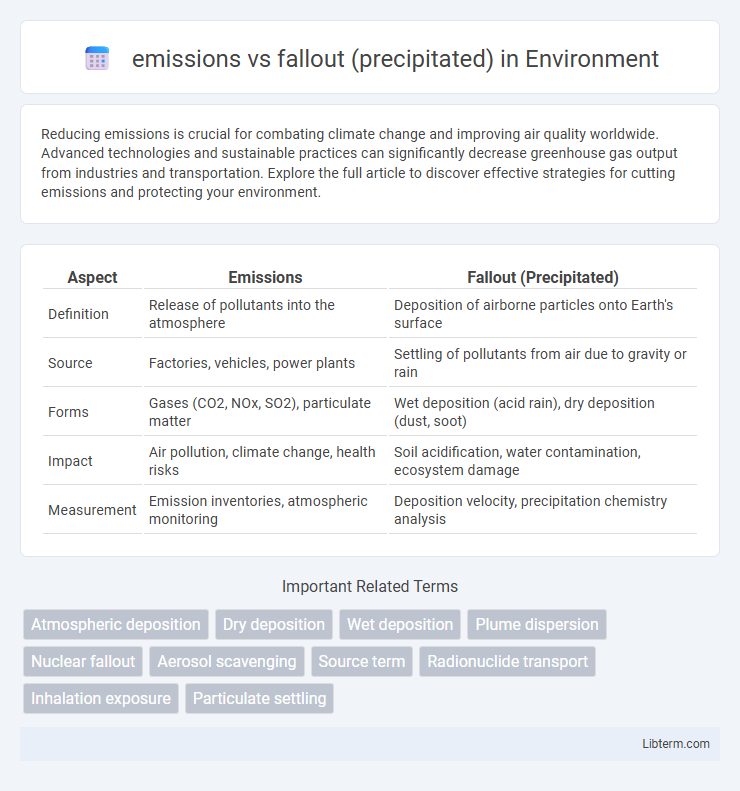Reducing emissions is crucial for combating climate change and improving air quality worldwide. Advanced technologies and sustainable practices can significantly decrease greenhouse gas output from industries and transportation. Explore the full article to discover effective strategies for cutting emissions and protecting your environment.
Table of Comparison
| Aspect | Emissions | Fallout (Precipitated) |
|---|---|---|
| Definition | Release of pollutants into the atmosphere | Deposition of airborne particles onto Earth's surface |
| Source | Factories, vehicles, power plants | Settling of pollutants from air due to gravity or rain |
| Forms | Gases (CO2, NOx, SO2), particulate matter | Wet deposition (acid rain), dry deposition (dust, soot) |
| Impact | Air pollution, climate change, health risks | Soil acidification, water contamination, ecosystem damage |
| Measurement | Emission inventories, atmospheric monitoring | Deposition velocity, precipitation chemistry analysis |
Understanding Emissions: Sources and Types
Emissions refer to pollutants released directly into the atmosphere from sources such as industrial factories, vehicles, and natural events like wildfires. These emissions consist of gases like carbon dioxide, sulfur dioxide, nitrogen oxides, and particulate matter that contribute to air pollution and environmental degradation. Understanding the types and sources of emissions is crucial for developing targeted regulations and technologies to reduce their impact on climate change and human health.
What Is Fallout (Precipitated) and How Does It Occur?
Fallout (precipitated) refers to particulate matter and pollutants that settle from the atmosphere onto surfaces after being emitted into the air. This process occurs when airborne particles coagulate, grow in size through condensation or chemical reactions, and become too heavy to remain suspended, eventually falling to the ground. Fallout significantly impacts environmental quality by depositing harmful substances, including heavy metals and radioactive materials, which can contaminate soil and water resources.
Key Differences Between Emissions and Fallout
Emissions refer to the release of pollutants such as gases, particulates, or chemicals into the atmosphere from sources like factories, vehicles, or natural events. Fallout, or precipitated fallout, consists of these emitted particles or substances that have settled out of the air and deposited onto surfaces, often through processes like gravity or precipitation. Key differences between emissions and fallout lie in their state and location--emissions are airborne discharges, while fallout represents the deposited residues affecting soil, water, and living organisms.
Environmental Impacts of Emissions
Emissions release pollutants such as sulfur dioxide (SO2), nitrogen oxides (NOx), and particulate matter directly into the atmosphere, contributing to air quality degradation and climate change. Fallout or precipitated pollutants, including acid rain and heavy metal deposition, result from these emissions reacting in the atmosphere and settling on soil and water bodies, causing ecosystem damage and soil acidification. The environmental impacts of emissions encompass respiratory health issues, biodiversity loss, and altered biogeochemical cycles due to both airborne pollutants and their subsequent fallout effects.
Fallout Consequences: Effects on Ecosystems
Fallout, consisting of precipitated radioactive particles, severely disrupts ecosystems by contaminating soil, water sources, and vegetation, leading to bioaccumulation in plants and animals. This contamination causes long-term genetic mutations, reproductive failures, and population declines across multiple trophic levels. The persistent nature of fallout elements such as cesium-137 and strontium-90 poses sustained ecological risks, altering species diversity and ecosystem functions for decades.
Monitoring Air Emissions vs Fallout Deposition
Monitoring air emissions involves measuring pollutants released directly into the atmosphere from sources such as factories and vehicles, providing real-time data on contaminant concentrations and emission rates. Fallout deposition refers to the collection of airborne particles and gases that settle onto surfaces, requiring sampling through deposition gauges to assess cumulative pollutant load over time. Effective environmental management integrates continuous air emission monitoring with fallout deposition analysis to evaluate both immediate atmospheric pollution levels and longer-term surface contamination impacts.
Regulatory Approaches: Controlling Emissions and Fallout
Regulatory approaches to controlling emissions focus on setting strict limits on pollutants released into the atmosphere, using permits, monitoring systems, and technology standards to reduce airborne contaminants. In contrast, fallout or precipitated pollutants are managed by controlling particulate emissions at the source, implementing filtration systems, and enforcing deposition limits to minimize environmental accumulation. Effective regulations integrate both emissions controls and fallout monitoring to ensure comprehensive air quality and public health protection.
Real-World Case Studies: Emissions vs Fallout Events
Real-world case studies reveal significant differences between emissions and fallout events in terms of environmental impact and dispersion patterns. Emissions from industrial sources often consist of gaseous pollutants and fine particulates, dispersing widely and contributing to atmospheric pollution, whereas fallout events typically involve larger particulates precipitating directly to the ground, causing localized contamination. Notable examples include the Chernobyl nuclear disaster, where radioactive fallout settled over wide areas, contrasting with urban smog episodes like those in Los Angeles, driven primarily by continuous emissions of nitrogen oxides and volatile organic compounds.
Mitigation Strategies for Emissions and Fallout Reduction
Mitigation strategies for emissions prioritize source control techniques such as advanced filtration systems, catalytic converters, and the adoption of cleaner fuels to reduce airborne pollutants before they disperse. In contrast, fallout reduction focuses on capturing precipitated particles through improved land and water management practices, including vegetation buffers, sedimentation basins, and soil stabilization to prevent environmental contamination. Integrating real-time monitoring technologies with regulatory frameworks further enhances the effectiveness of both emission controls and fallout reduction measures, minimizing overall environmental and public health risks.
Future Trends in Managing Emissions and Fallout
Future trends in managing emissions and fallout emphasize advanced monitoring technologies and predictive analytics to minimize environmental impact. Emission control strategies increasingly integrate real-time data and AI to optimize reduction efforts while improving the efficiency of precipitation-based fallout capture systems. Innovations in material science enhance the effectiveness of fallout filtration, supporting stricter regulatory standards and sustainable industrial practices.
emissions Infographic

 libterm.com
libterm.com